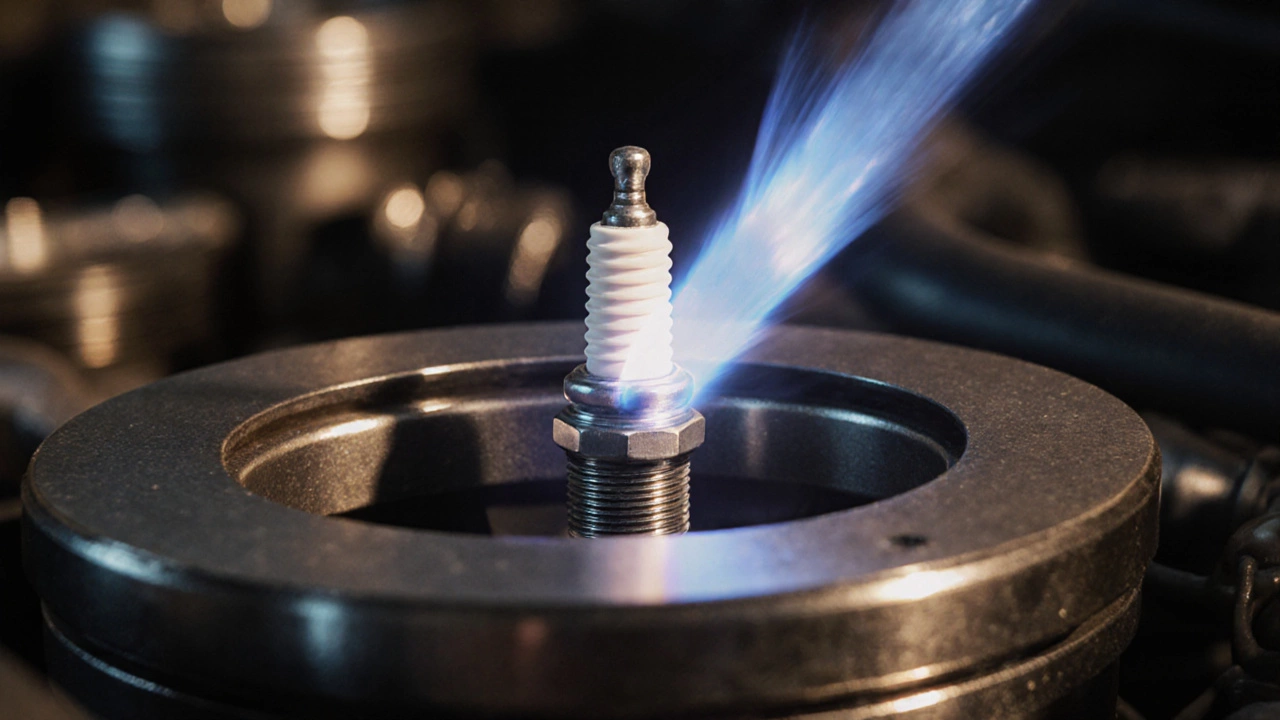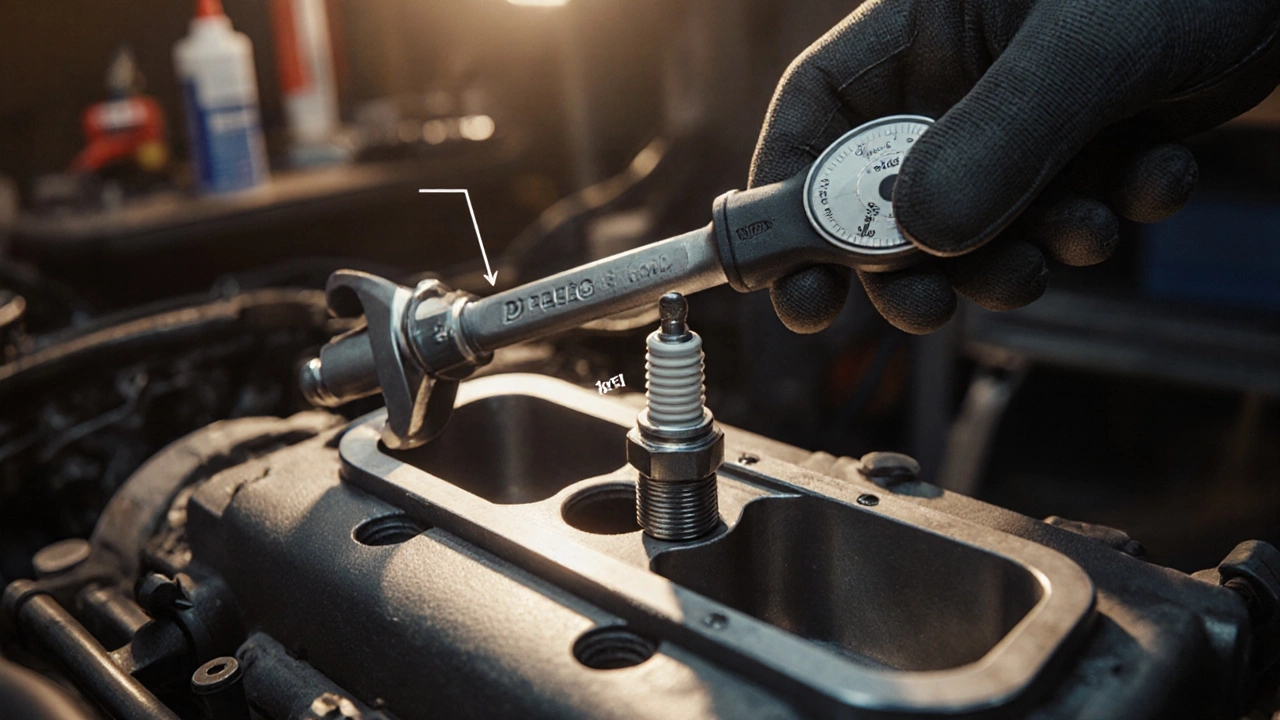How Long Does a Spark Plug Last? Lifespan, Factors, and Replacement Guide
 Oct, 11 2025
Oct, 11 2025
Spark Plug Replacement Interval Calculator
Calculate the ideal spark plug replacement interval for your vehicle based on manufacturer specifications and your driving conditions.
When it’s time to keep your engine humming, Spark Plug is a small, electrically charged device that creates the spark needed to ignite the air‑fuel mixture in a combustion chamber. Knowing how long a spark plug can reliably work saves money, avoids poor performance, and keeps emissions in check. This guide breaks down the numbers, the variables, and the exact steps to decide when to swap them out.
Quick Takeaways
- Typical spark plug life ranges from 20,000mi for copper plugs to 100,000mi for iridium or platinum plugs.
- Driving style, heat range, fuel quality and engine load are the biggest wear drivers.
- Follow the vehicle‑manufacturer’s mileage recommendation, but adjust for severe‑use conditions.
- Inspect gap, fouling and electrode wear at each oil change for early warning signs.
- Using the correct torque (usually 13-20lb‑ft) and gap setting extends life and prevents damage.
Let’s dig into what really decides a spark plug lifespan and how you can get the most mileage out of each one.
What Determines Spark Plug Life?
Even though a spark plug looks simple, it operates in a harsh environment. The following factors are the main culprits that eat away at its useful life:
- Heat Range - A plug’s heat range tells how quickly it can dissipate heat. A plug that’s too hot will over‑heat the electrode, while one that’s too cold can cause fouling. Matching the heat range to your engine’s operating temperature is crucial.
- Electrode Material - Copper plugs wear fastest (≈20,000mi), while platinum (≈60,000mi) and iridium (≈100,000mi) last much longer because of higher melting points and finer electrodes.
- Driving Conditions - Short trips, stop‑and‑go traffic, and high‑load towing keep the engine at lower temperatures, encouraging carbon deposits. Highway cruising at steady rpm tends to be gentler on plugs.
- Fuel Quality - High‑octane, clean fuel reduces carbon buildup. Low‑quality or ethanol‑heavy fuel can increase fouling.
- Engine Load & Tuning - Aggressive timing, high boost, or performance‑tuned engines run hotter, accelerating electrode erosion.
- OEM vs. Aftermarket - Original equipment manufacturer (OEM) plugs are calibrated for the specific engine, while some aftermarket plugs may offer higher performance but require more frequent checks.
- Installation Torque & Gap - Over‑tightening can crack the ceramic insulator; under‑tightening leads to vibration. Incorrect gap (too wide or narrow) stresses the electrode.

Typical Lifespan by Vehicle Type and Driving Conditions
| Vehicle Type | Plug Material | Normal Driving (mixed city/highway) | Severe Driving (towing, racing, short trips) |
|---|---|---|---|
| Compact Car (4‑cyl) | Copper | 20,000mi | 15,000mi |
| Compact Car (4‑cyl) | Platinum/Iridium | 60,000mi / 90,000mi | 45,000mi / 70,000mi |
| SUV / Light Truck (V6/V8) | Copper | 18,000mi | 12,000mi |
| SUV / Light Truck (V6/V8) | Platinum/Iridium | 55,000mi / 85,000mi | 40,000mi / 65,000mi |
| Performance / Sports (high‑rev) | Copper | 15,000mi | 10,000mi |
| Performance / Sports (high‑rev) | Iridium | 80,000mi | 55,000mi |
These numbers are averages taken from manufacturer service bulletins, automotive repair databases, and real‑world long‑term maintenance logs. Always start with the interval listed in your owner’s manual, then adjust up or down based on the conditions above.
Warning Signs That Your Spark Plug Is Wearing Out
- Misfire or Rough Idle - When one or more plugs fail to fire, the engine shakes at low rpm.
- Reduced Power & Acceleration - A weak spark limits combustion efficiency, noticeable during passing or hill climbs.
- Increased Fuel Consumption - The engine compensates for incomplete combustion by using more fuel.
- Hard Starts, Especially in Cold Weather - A weak spark makes ignition harder when the engine is cold.
- Engine Light (Check Engine) - Fault codes P0300‑P0306 typically point to misfire issues caused by plug problems.
- Visible Fouling - Black, oily or carbon buildup on the electrode when you remove the plug.
How to Decide the Right Replacement Interval
Instead of blindly following mileage charts, combine three practical checks:
- Manufacturer Recommendation - Start with the mileage or time interval in the owner’s manual.
- Condition Check at Service - When you change the oil, pull one plug (or all, if easily accessible) and inspect gap, electrode wear, and fouling.
- Operating Environment - If you tow heavy loads, race on weekends, or live in a dusty area, cut the interval by 25‑30%.
Document the mileage and condition each time you inspect. Over a few cycles you’ll see a pattern and can set a personalized replacement schedule.

Step‑by‑Step: Replacing a Spark Plug the Right Way
Here’s a straightforward process that works for most gasoline‑engine vehicles. If you have a diesel engine, skip the spark plug step - diesel uses glow plugs instead.
- Gather Tools - Ratchet with socket (usually 5/8" or 16mm), spark plug gap tool, torque wrench (13‑20lb‑ft range), dielectric grease, and the correct replacement plugs.
- Cool the Engine - Wait at least 15minutes after shutdown to avoid burns and prevent the ceramic from cracking.
- Locate the Plugs - Follow the ignition coil or spark‑plug‑wire leads. In modern coils‑on‑plugs (COP) systems, the coil sits directly on top of each plug.
- Remove the Ignition Coil - Disconnect the electrical connector, unscrew the mounting bolt, and gently lift the coil away.
- Unscrew the Old Plug - Turn counter‑clockwise with the socket. If it’s seized, apply a penetrating oil and wait a few minutes.
- Check Gap on New Plug - Using the gap tool, set the gap to the specification printed on the plug’s side (often 0.028‑0.044in). Adjust gently; don’t force.
- Apply Dielectric Grease - Lightly coat the threads of the new plug. This prevents moisture corrosion and eases future removal.
- Install the New Plug - Hand‑tighten until the plug seats, then use the torque wrench to apply the exact torque (refer to the vehicle’s service manual - usually 13‑20lb‑ft).
- Re‑install the Coil - Place the coil back, reconnect the connector, and secure the bolt.
- Repeat for Remaining Cylinders - Work methodically to avoid mixing up plugs.
- Start the Engine - Listen for a smooth idle. A brief stumble is normal as the ECU relearns the new spark timing.
That’s it. The whole job often takes 30‑45minutes on a regular passenger car.
Pro Tips to Extend Spark Plug Life
- Use premium fuel when the manufacturer recommends it - it reduces carbon deposits.
- Keep the engine’s cooling system in top shape; an overheating engine accelerates electrode erosion.
- Install a quality fuel‑filter; clogged filters send unburned fuel to the plug, causing fouling.
- Consider iridium plugs for high‑rev or turbocharged engines - the cost difference is offset by the longer interval.
- Periodically clean the plug threads with a soft brush before reinstalling; debris can cause cross‑threading.
- Never reuse a plug that’s been removed - the ceramic insulator can develop micro‑cracks that aren’t visible.
Frequently Asked Questions
How often should I check my spark plug gap?
Inspect the gap at every oil change (typically every 5,000‑7,500mi). If you notice any misfire symptoms, check immediately. Most modern plugs hold the gap for their full service life, but extreme heat can cause the electrode to wear down.
Can I mix copper and iridium plugs in the same engine?
Mixing materials is not recommended. Different heat ranges and electrode sizes affect how each cylinder burns. Uniform plugs ensure consistent combustion and prevent uneven wear.
What torque should I use for most spark plugs?
Most passenger‑car spark plugs require 13‑20lb‑ft (18‑27Nm). Always confirm the exact value in the service manual, as some high‑performance engines specify tighter torques.
Why does my check‑engine light flash during a cold start?
A flashing code usually means a severe misfire (P0300‑P0306). A weak or fouled spark plug is a common cause, especially when the engine is cold and the mixture is richer.
Do aftermarket performance plugs actually improve power?
They can, but only when the engine is tuned to take advantage of the hotter heat range or finer electrode. In a stock engine, the gain is usually marginal and the plug may wear faster.
By understanding the variables that affect spark plug wear, you can plan replacements smarter, avoid surprise breakdowns, and keep your engine running cleanly for as long as possible.